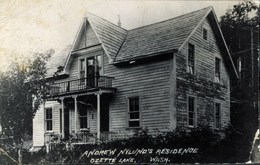
NPS The westward homestead wave reached the Olympic Peninsula in the mid-19th century. The earliest settlers clustered along the coast, near Hood Canal and present-day Port Townsend, Sequim, Port Angeles, and Neah Bay. In 1891 the Seattle Post-Intelligencer reported on Charles and Samuel Gilman's journey through the western Olympic Peninsula. They praised the potentially fertile soil, excellent pasturage, and abundant rainfall. Though infant colonies were established around the coastline, and isolated settlements and individual homesteads circled the inner core, their prediction that many people would come to settle never came true. Homestead life on the remote Olympic Peninsula was tedious and hard. It began with building a cabin. Unless they used clearings maintained by local tribes, settlers expended enormous effort to clear the imposing forests for gardens, orchards and pastures. In the long, rainy winters, hunting and fishing helped feed the family. The challenges proved too much for many. But those that remained often wrote of the beauty and vast resources in correspondence to family back east. Slowly, the peninsula began to draw attention.
Settlement of the land now part of Olympic National Park took place in different areas, at different times, by different peoples, for different reasons. Learn more at the links to the right.
|
Last updated: September 8, 2022
